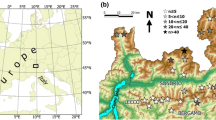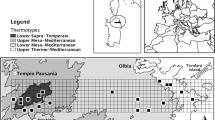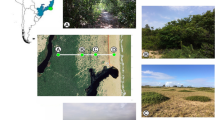Abstract
Studies on the composition and structure of living organisms communities in terms of their functional traits became very popular the last decades. The functional approach is widespread, but is still rarely applied for solving two associated questions: (1) how species from a given community differ from random samples in their mean values of functional traits (with the same number of species) of local flora; (2) how much mean values of functional traits in community species differ from community weighted means (by species abundance), or, in other words, how much higher or lower are these values in dominants compared with those of other species. The aim of this study was to answer these questions using the example of alpine communities of the northwestern Caucasus. We studied leaf functional traits in four types of alpine communities, which cover maximum area in the alpine belt of the northwestern Caucasus: alpine lichen heaths (ALH), Festuca varia grasslands (FVG), Geranium–Hedysarum meadows (GHM) and alpine snowbeds (SB). Water saturated leaves of ALH plants had a significantly lower mass and specific leaf area (SLA) but a higher dry matter content compared with the samples of species from “random” communities. The dominants of this community had smaller leaves with a higher dry matter content and a lower SLA. Leaves of FVG plants had a lower area and wet mass, but a higher dry mass, while dominants had a higher leaf dry mass and dry matter content, but a lower leaf area and SLA. For the plants from more productive GHM, larger leaves and higher dry matter content are typical compared with “random” species samples. Only three size traits (leaf area, wet mass, and dry mass) were significantly higher in the dominants of GHM in comparison with other species of this community. Plants of alpine snowbeds, which grow under late snowmelt time and short growth season, had smaller leaves with high dry matter content and SLA. The dominants of these communities, in contrast, have larger leaves compared with other species of SB. The results we obtained confirm the delimiting role of stress tolerance for establishment of communities in habitats with low snow cover and for dominance there (ALH and FVG), the significant role in competitive strategy of more large-leaved species in more productive GHM and comparatively high role of ruderality in formation of SB.


Similar content being viewed by others
REFERENCES
Aiello-Lammens, M.E., Slingsby, J.A., Merow, C., Mollmann, H.K., Euston-Brown, D., et al., Processes of community assembly in an environmentally heterogeneous, high biodiversity region, Ecography, 2017, vol. 40, no. 4, pp. 561–576.
Bjorkman, A.D., Myers-Smith, I.H., Elmendorf, S.C., Normand, S., Thomas, H.J.D., et al., Tundra trait team: a database of plant traits spanning the tundra biome, Global Ecol. Biogeogr., 2018, vol. 27, no. 12, pp. 1402–1411.
Borgy, B., Violle, C., Choler, P., Garnier, E., Kattge, J., et al., Sensitivity of community-level trait-environment relationships to data representativeness, Global Ecol. Biogeogr., 2017, vol. 26, no. 6, pp. 729–739.
Butterfield, B.J. and Suding, K.N., Single-trait functional indices outperform multi-trait indices in linking environmental gradients and ecosystem services in a complex landscape, J. Ecol., 2013, vol. 101, no. 1, pp. 9–17.
Cadotte, M.W., Functional traits explain ecosystem function through opposing mechanisms, Ecol. Lett., 2017, vol. 20, no. 8, pp. 989–996.
Chagnon, P.-L., Bradley, R.L., and Klironomos, J.N., Trait-based partner selection drives mycorrhizal network assembly, Oikos, 2015, vol. 124, no. 12, pp. 1609–1616.
Cornelissen, J.H.C., Lavorel, S., Garnier, E., Diaz, S., Buchmann, N., et al., A handbook of protocols for standardised and easy measurements of plant functional traits worldwide, Aust. J. Bot., 2003, vol. 51, no. 4, pp. 335–380.
Cornwell, W.K. and Ackerly, D.D., Community assembly and shifts in plant trait distributions across an environmental gradient in coastal California, Ecol. Monogr., 2009, vol. 79, no. 1, pp. 109–126.
Denelle, P., Violle, C., and Munoz, F., Distinguishing the signatures of local environmental filtering and regional trait range limits in the study of trait-environment relationships, Oikos, 2019, vol. 128, no. 7, pp. 960–971.
Douma, J.C., Aerts, R., Witte, J.P.M., Bekker, R.M., Kunzmann, D., et al., A combination of functionally different plant traits provides a means to quantitatively predict a broad range of species assemblages in NW Europe, Ecography, 2012, vol. 35, no. 4, pp. 364–373.
Dudova, K.V., Ataballyev, G.G., Akhmetzhanova, A.A., Gulov, D.M., Dudov, S.V., et al., Plant height as a functional trait of alpine plants, Byull. Mosk. O-va Ispyt. Prir., Otd. Biol., 2019, vol. 124, no. 1, pp. 33–46.
Elumeeva, T.G., Onipchenko, V.G., Rovnaia, E.N., Wu, Y., and Werger, M.J.A., Alpine plant communities of Tibet and Caucasus: In quest of functional convergence, Botanica Pacifica, 2015, vol. 4, no. 1, pp. 1–10.
Finegan, B., Peña-Claros, M., De Oliveira, A., Ascarrunz, N., Bret-Harte, M.S., et al., Does functional trait diversity predict aboveground biomass and productivity of tropical forests? Testing three alternative hypotheses, J. Ecol., 2015, vol. 103, no. 1, pp. 191–201.
Fisher, R.A., The Genetical Theory of Natural Selection, Oxford: Clarendon, 1930, 1st ed.
Franzen, M., Dieker, P., Schrader, J., and Helm, A., Rapid plant colonization of the forelands of a vanishing glacier is strongly associated with species traits, Arctic, Antarctic, and Alpine Research, 2019, vol. 51, no. 1, pp. 366–378.
Garnier, E., Navas, M.L., and Grigulis, K., Plant Functional Diversity, Oxford: Oxford Univ. Press, 2016.
Garnier E., Cortez J., Billes G., Navas M.-L., Roumet C., et al., Plant functional markers capture ecosystem properties during secondary succession, Ecology., 2004, vol. 85, no. 9, pp. 2630–2637.
Grime, J.P., Benefits of plant diversity to ecosystems: Immediate, filter, and founder effects, J. Ecol., 1998, vol. 86, no. 6, pp. 902–910.
Grime, J.P., Plant Strategies, Vegetation Processes, and Ecosystem Properties, Chichester: John Wiley and Sons, 2001, 2nd ed.
Gross N., Robson T.M., Lavorel S., Albert C., Le Bagousse-Pinguet Y., Guillemin R., Plant response traits mediate the effects of subalpine grasslands on soil moisture, New Phytol., 2008, vol. 180, pp. 652–662.
Hulshof, C.M., Violle, C., Spasojevic, M.J., McGill, B., Damschen, E., et al., Intra-specific and inter-specific variation in specific leaf area reveal the importance of abiotic and biotic drivers of species diversity across elevation and latitude, J. Veg. Sci., 2013, vol. 24, no. 5, pp. 921–931.
Jiang, Y., Zang, R., Lu, X., Huang, Y., Ding, Y., et al., Effects of soil and microclimatic conditions on the community-level plant functional traits across different tropical forest types, Plant Soil, 2015, vol. 390, nos. 1–2, pp. 351–367.
Kichenin, E., Wardle, D.A., Peltzer, D.A., Morse, C.W., and Freschet, G.T., Contrasting effects of plant inter- and intraspecific variation on community-level trait measures along an environmental gradients, Funct. Ecol., 2013, vol. 27, no. 5, pp. 1254–1261.
Komac, B., Pladevall, C., Penuelas, J., Conesa, J.V., and Domenech, M., Variations in functional diversity in snowbed plant communities determining snowbed continuity, Plant Ecol., 2015, vol. 216, no. 9, pp. 1257–1274.
Kunstler, G., Falster, D., Coomes, D.A., Hui, F., Kooyman, R.M., et al., Plant functional traits have globally consistent effects on competition, Nature, 2016, vol. 529, no. 7585, pp. 204–207.
Ladouceur, E., Bonomi, C., Bruelheide, H., Klimesova, J., Burrascano, S., et al., The functional trait spectrum of European temperate grasslands, J. Veg. Sci., 2019, vol. 30, no. 5, pp. 777–788.
Laliberté, E., Legendre, P., and Shipley, B., FD: Measuring functional diversity from multiple traits, and other tools for functional ecology, R package version 1.0-12, 2014. https://cran.r-project.org/web/packages/FD/index.html.
Laughlin, D.C., Gremer, J.R., Adler, P.B., Mitchell, R.M., and Moore, M.M., The net effect of functional traits on fitness, Trends Ecol. Evol., 2020, vol. 35, no. 11, pp. 1037–1047.
Lavorel, S., Díaz, S., Cornelissen, J.H.C., Garnier, E., Harrison, S.P., et al., Plant functional types: Are we getting any closer to the Holy Grail?, in Terrestrial Ecosystems in a Changing World, Berlin: Springer-Verlag, 2007, pp. 149–164.
Luo, S., Schmid, B., Wagg, C., Chen, Y., Jiang, B., et al., Community-wide trait means and variations affect biomass in a biodiversity experiment with tree seedlings, Oikos, 2020, vol. 129, no. 6, pp. 799–810.
Majekova, M., Bello, F., Dolezal, J., and Leps, J., Plant functional traits as determinants of population stability, Ecology, 2014, vol. 95, no. 9, pp. 2369–2374.
Messier, J., McGill, B.J., Enquist, B.J., and Lechowicz, M.J., Trait variation and integration across scales: Is the leaf economic spectrum present at local scales?, Ecography, 2017, vol. 40, no. 6, pp. 685–697.
Mirkin, B.M. and Naumova, L.G., Nauka o rastitel’nosti (Vegetation Science), Ufa: Gilem, 1998.
Onipchenko, V.G., Structure, phytomass and productivity of Alpine lichen barrens, Byull. Mosk. O-va Ispyt. Prir., Otd. Biol., 1985, vol. 90, no. 1, pp. 59–66.
Onipchenko, V.G., Phytomass of Alpine communities of the Northwestern Caucasus, Byull. Mosk. O-va Ispyt. Prir., Otd. Biol., 1990, vol. 95, no. 6, pp. 52–62.
Onipchenko, V.G., The structure and dynamics of alpine plant communities in the Teberda Reserve, the Northwestern Caucasus, Oecologia Montana, 1994, vol. 3, no. 1, pp. 40–50.
Onipchenko, V.G., Alpine Vegetation of the Teberda Reserve, the Northwestern Caucasus, Zurich: Geobotanischen Institutes der ETH, Stiftung Rubel, 2002.
Onipchenko, V.G. and Semenova, G.V., Comparative analysis of the floristic richness of alpine communities in the Caucasus and the Central Alps, J. Veg. Sci., 1995, vol. 6, no. 2, pp. 299–304.
Onipchenko, V.G., Semenova, G.V., and Van der Maarel, E., Population strategies in severe environments: Alpine plants in the Northwestern Caucasus, J. Veg. Sci., 1998, vol. 9, no. 1, pp. 27–40.
Onipchenko, V.G., Blinnikov, M.S., Gerasimova, M.A., Volkova, E.V., and Cornelissen, J.H.C., Experimental comparison of competition and facilitation in alpine communities varying in productivity, J. Veg. Sci., 2009, vol. 20, no. 4, pp. 718–727.
Onipchenko, V.G., Zernov, A.S., and Vorob’eva, F.M., Sosudistye rasteniya Teberdinskogo zapovednika (Vascular Plants of the Teberdinsky Reserve), Moscow: MaksPress, 2011.
Onipchenko, V.G., Rozhin, A.O., Smirnov, V.E., Akhmetzhanova, A.A., Elumeeva, T.G., et al., Do patterns of intra-specific variability and community weighted-means of leaf traits correspond? An example from Alpine plants, Botanica Pacifica, 2020, vol. 9, no. 1, pp. 53–61.
Onipchenko, V.G., Dudova, K.V., Akhmetzhanova, A.A., et al., Which plant strategies are related to dominance in Alpine communities?, Biol. Bull. Rev., 2021, vol. 11, no. 1, pp. 76–85.
Pérez-Harguindeguy, N., Diaz, S., Garnier, E., Lavorel, S., Poorter, H., et al., New handbook for standardized measurement of plant functional traits worldwide, Aust. J. Bot., 2013, vol. 61, no. 3, pp. 167–234.
Petchey O.L., Gaston K.J., Functional diversity: back to basics and looking forward, Ecol. Lett., 2006, vol. 9, pp. 741–758.
Pfestorf, H., Weiss, L., Müller, J., Boch, S., Socher, S.A., et al., Community mean traits as additional indicators to monitor effects of land-use intensity on grassland plant diversity Perspectives in Plant Ecology, Evolution and Systematics, 2013, vol. 15, no. 1, pp. 1–11.
Pierce, S., Brusa, G., Vagge, I., and Cerabolini, B.E.L., Allocating CSR plant functional types: The use of leaf economics and size traits to classify woody and herbaceous vascular plants, Funct. Ecol., 2013, vol. 27, no. 4, pp. 1002–1010.
Pierce, S., Negreiros, D., Cerabolini, B.E.L., Kattge, J., Diaz, S., et al., A global method for calculating plant csr ecological strategies applied across biomes world-wide, Funct. Ecol., 2017, vol. 31, no. 2, pp. 444–457.
Price, J.N., Gazol, A., Tamme, R., Hiiesalu, I., and Partel, M., The functional assembly of experimental grasslands in relation to fertility and resource heterogeneity, Funct. Ecol., 2014, vol. 28, no. 2, pp. 509–519.
Price, J., Tamme, R., Gazol, A., Bello, F., Takkis, K., et al., Within-community environmental variability drives trait variability in species-rich grasslands, J. Veg. Sci., 2017, vol. 28, no. 2, pp. 303–312.
Quetier F., Thebault A., Lavorel S., Plant traits in a state and transition framework as markers of ecosystem response to land-use change, Ecol. Monogr., 2007, vol. 77, pp. 33–52.
R Core Team, The R Foundation for Statistical Computing, 2020. https://www.R-project.org/.
Rabotnov, T.A., On the types of plant strategy, Ekologiya, 1985, no. 3, pp. 3–12.
Ramenskii L.G., On the fundamental principles, basic concepts and terms of the production typology of lands, geobotany and ecology, Sov. Bot., 1935, no. 4, pp. 25–40.
Rosado, B.H.P. and De Mattos, E.A., On the relative importance of CSR ecological strategies and integrative traits to explain species dominance at local scales, Funct. Ecol., 2017, vol. 31, no. 10, pp. 1969–1974.
Scherer-Lorenzen M., Functional diversity affects decomposition processes in experimental grasslands, Funct. Ecol., 2008, vol. 22, pp. 547–555.
Shipley, B., Belluau, M., Kühn, I., Soudzilovskaia, N.A., Bahn, M., et al., Predicting habitat affinities of plant species using commonly measured functional traits, J. Veg. Sci., 2017, vol. 28, no. 5, pp. 1082–1095.
Swenson, N.G., Phylogenetic imputation of plant functional trait databases, Ecography, 2014, vol. 37, no. 2, pp. 105–110.
Thomas, H.J.D., Myers-Smith, I.H., Bjorkman, A.D., Elmendorf, S.C., Blok, D., et al., Traditional plant functional groups explain variation in economic but not size-related traits across the tundra biome, Global Ecol. Biogeogr., 2019, vol. 28, no. 2, pp. 78–95.
Tilman D., Functional diversity, Encyclopedia of Biodiversity, Ed. Levin S.A. San Diego: Academic Press. 2001, vol. 3, pp. 109–120.
Verheijen, L.M., Aerts, R., Bönisch, G., Kattge, J., and Van Bodegom, P.M., Variation in trait trade-offs allows differentiation among predefined plant functional types: Implications for predictive ecology, New Phytol., 2016, vol. 209, no. 2, pp. 563–575.
Wagg, C., Ebeling, A., Roscher, C., Ravenek, J., Bachmann, D., et al., Functional trait dissimilarity drives both species complementarity and competitive disparity, Funct. Ecol., 2017, vol. 31, no. 12, pp. 2320–2329.
Westoby, M., A leaf-height-seed (LHS) plant ecology strategy scheme, Plant Soil, 1998, vol. 199, no. 2, pp. 213–227.
Westoby, M., Falster, D.S., Moles, A.T., Vesk, P.A., and Wright, I.J., Plant ecological strategies: some leading dimensions of variation between species, Annu. Rev. Ecol. Syst., 2002, vol. 33, pp. 125–159.
Wickham, H., The split-apply-combine strategy for data analysis, Journal of Statistical Software, 2011, vol. 40, no. 1, pp. 1–29.
Wickham, H., ggplot2: Elegant Graphics for Data Analysis, New York: Springer, 2016.
Wickham, H., François, R., Henry, L., and Müller, K., dplyr: A Grammar of Data Manipulation. R package version 1.0.7., 2021. https://CRAN.R-project.org/package=dplyr.
Funding
The work was supported by the Russian Foundation for Basic Research, project no. 20-04-00544.
Author information
Authors and Affiliations
Corresponding author
Ethics declarations
COMPLIANCE WITH ETHICAL STANDARDS
This article does not contain the results of any research using animals as subjects.
CONFLICT OF INTEREST
The authors declare that they have no conflicts of interest.
Rights and permissions
About this article
Cite this article
Onipchenko, V.G., Dudova, K.V., Gulov, D.M. et al. Leaf Functional Traits Are Important for the Formation of Alpine Plant Community Composition. Biol Bull Rev 13, 228–237 (2023). https://doi.org/10.1134/S2079086423030064
Received:
Revised:
Accepted:
Published:
Issue Date:
DOI: https://doi.org/10.1134/S2079086423030064




